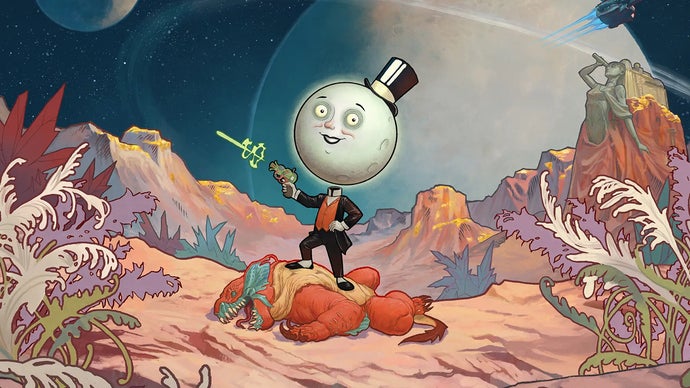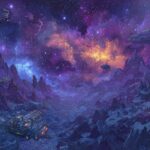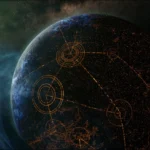The Outer Worlds was a pretty big deal for me when it was released six years ago, effectively taking the same gameplay style of Fallout: New Vegas and transplanting it into a spacefaring adventure in a distant colony among the stars called Halcyon. That was all I needed; something a bit fresher, newer, with a sense of humour. The Outer Worlds 2 takes us to another colony, Arcadia, and aims to do the same again. Arguably, with middling success.
The game begins with you working for the Earth Directorate on a crucial mission…which inevitably goes wrong, leaving you floating in space cryogenically frozen. Once you’re woken by an incredibly loyal soldier who spent ten years looking for you, Arcadia is in a bit of a bad place. There’s giant rifts taking over, threatening the destruction of the whole colony, not to mention that Auntie’s Choice – the result of the Auntie Cleo corporation from the first game taking over Spacer’s Choice – seeks to gain control of the colony from the authoritarian Protectorate.
As you can see, it’s all very involved and, once again, the writing and world are The Outer Worlds 2’s brightest part, full of detail and wit at every turn. From the absurd job titles of NPCs to elaborate setups for jokes, the game is relentlessly entertaining as you uncover its secrets, but it has pulled back a little bit as well. The jingles that played when you use a vending machine have been toned down to a few notes now, there’s a handful of vendors that use the prescribed corporate greetings when you interact, but they’re all near the beginning and that behaviour mysteriously disappears later on. It’s admittedly the more obnoxious bits that are missing or toned down, but I do almost miss the more noticeable jingle as it’s one of the few things that gives this series its own identity.
The main story here is also a little underwhelming. There’s rifts everywhere, you need to find out why and then stop them. All the most interesting parts are where the rift stuff intersects with the rest of the world, andhow Auntie’s Choice, The Protectorate, and the cult of mathematicians The Order interact with it. The actual rift stuff is, itself, pretty cliched and uninteresting. It’s grand and colony threatening, sure, but that’s been done to death and isn’t particularly interesting here. Ingratiating yourself with and then negotiating with the factions and their heads, picking sides, and discovering all their secrets is where the best parts of the game are. Similarly, the side quests contain a lot of great stuff as well, especially the companion side quests, which you’ll want to do so you can improve their skills.
Speaking of the companions, they’re a varied bunch of lunatics, but they’re very interesting – even the rift death cultist. They’re idiots, though, constantly running directly into the line of fire, charging into a group of eight enemies and dying half a second later, sometimes inexplicably walking towards a group of enemies and then teleporting behind you, or repeating the same voice lines over and over. The AI doesn’t seem to have improved between games for either companions or enemies, the latter of which are mostly content to either run at you and dash between different pieces of cover at random whilst taking shots occasionally.
In fact, that’s not the only thing that hasn’t meaningfully changed between games, The map, for example, is still fiddly to use for fast travel because your cursor seems to magnetically attach to every icon other than the fast travel one your searching for. It’s also still unbalanced, with the game feeling fairly tough early on if you’re not careful, but gradually becomes a complete cakewalk, even though I ruined my character’s stats. The item modding and crafting systems are also still unwieldy and fiddly, with you scrolling through giant lists looking for the one thing you need. The same is true of your inventory as well; it’s difficult to tell guns apart from each other when you’ve collected thirty or so because the list is just icons and you have to highlight each one to see details.
There are some improvements though. The general gunplay is significantly better, with guns feeling like they have a little weight to them now, while the skill system has been simplified so stats now going up to 20 instead of 100, though you now only get 2 skill points to spend per level. Whilst I do think it can make the wait to level up your, say, hacking skill feel like it takes longer, I think overall it’s still a net gain as it has sped up levelling up significantly. You still only get a perk every other level, and there are a hell of a lot to choose from, so perhaps that’s better, if only to save me from reading through them all and agonising over the choice.
The flaw system also feels clearer. If you’re unfamiliar, these games will occasionally prompt you to take a flaw, something that gives you a negative effect in exchange for a positive. In the first game I always felt that the negative usually outweighed the positive, but here I gleefully took three flaws for my character and only regretted one of them! One, which adds 50% to the mag size of every single gun I use but reduces damage for a while if you let the gun run empty before reloading, was my favourite because having every single triple barrelled shotgun somehow fit two extra shots in its barrels – this was constantly funny to me. The one I regretted taking awarded me with an extra skill point every level, but made it so I could only invest points in skills that weren’t my most levelled up. This ended up locking me to having Lockpicking at level 8 until every other skill I’d invested points in reached the same point. I only managed to reach level 12 in any skills by the time I was at max level, so I missed out of a lot of higher skill checks. What I’m saying is that you should be careful picking flaws.
Graphically it’s a solid improvement, but as with a lot of this generation’s games, it’s probably not going to blow your socks off. It’s more aesthetically impressive than it is technically, but even so it does get a little bit same-y going through dilapidated retro-futurist sci-fi buildings. Where we previously had the city of Byzantium to show a more elaborate, less messy area for a change of pace, The Outer Worlds 2 has plenty of nice looking planets, but it’s all the same architecture and style across them.
I have experienced one crash through my 48 or so hours of play, during which I finished practically all side quests but for a few collectible ones. I’ve also experienced some audio cutting out, usually machinery in the background, and some awkward pauses between lines of dialogue, but nothing egregious that would really affect the experience.







